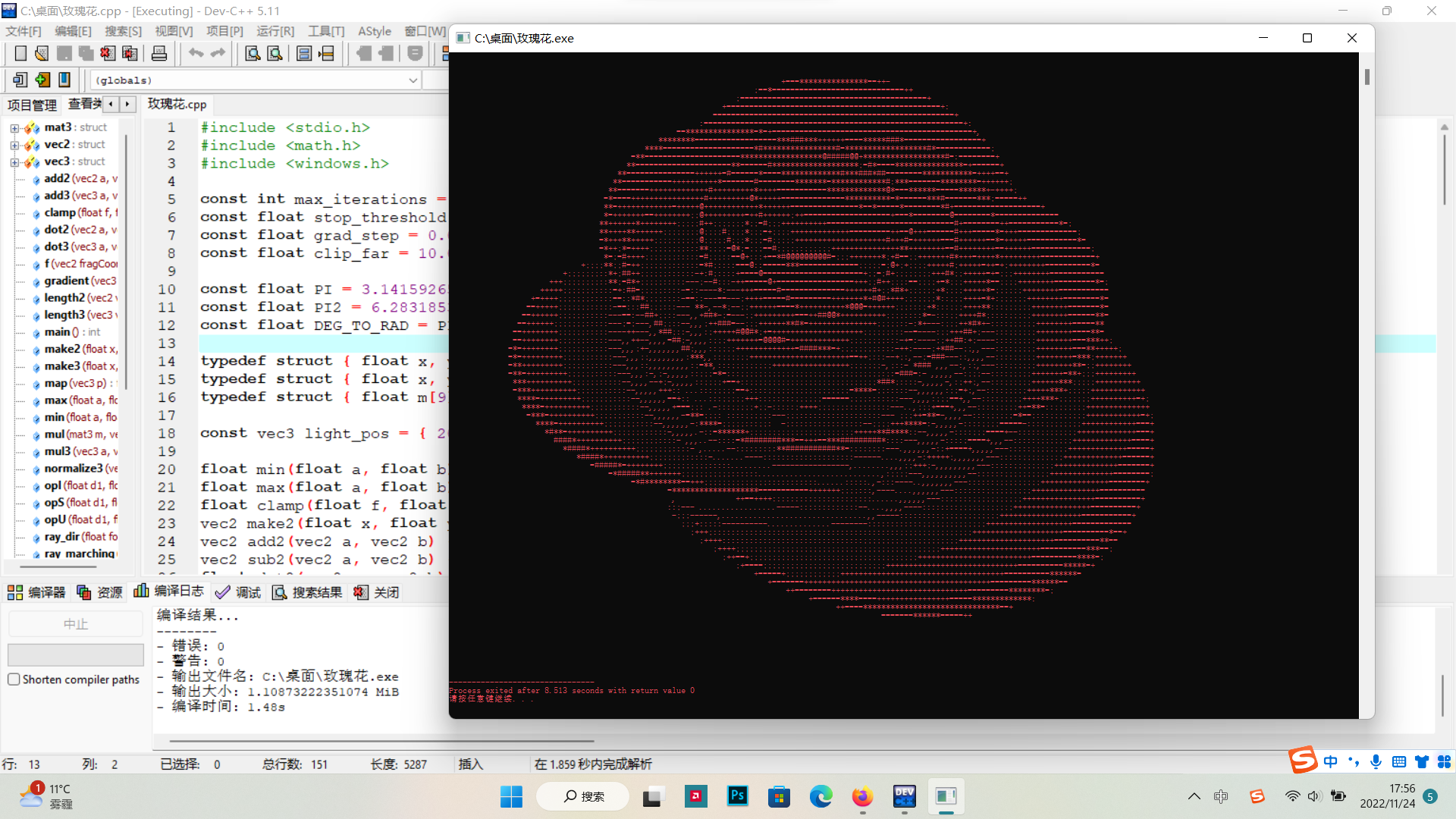
C语言代码:玫瑰花
C语言代码:玫瑰花古希腊神话中,玫瑰花集爱与美于一身!
·
前文
在古希腊神话中,玫瑰花集爱与美于一身,既是美神的化身,又溶进了爱神的血液,所以它所代表的含义是爱情。
我们应该用玫瑰花来表达我们的爱意,但是好多的恋人都是因为异地而没有办法去买一束新鲜的玫瑰去送给自己的爱人。
女孩子需要的只是一个态度而已,所以!我们男孩子要发挥自己的理性脑瓜来准备一份特殊的玫瑰何乐而不为呢!
so!接下来让我们用代码的方式亲手送出自己的那一份爱!❤
运行结果
(注意!!!!!!!运行出来如果玫瑰花太大的话!在控制台里摁着ctrl然后滑动鼠标的滚轮!一定要慢慢滚动!!!)

正文
准备事项
1.你得有个电脑
2.你得会操作电脑
3.你得会下载软件
4.是什么软件呢?(请看图片)
 ↑也行
↑也行
↓也行
 总之!这俩玩意儿都行!
总之!这俩玩意儿都行!
代码
#include <stdio.h>
#include <math.h>
#include <windows.h>
const int max_iterations = 128;
const float stop_threshold = 0.01f;
const float grad_step = 0.01f;
const float clip_far = 10.0f;
const float PI = 3.14159265359f;
const float PI2 = 6.28318530718f;
const float DEG_TO_RAD = PI / 180.0f;
typedef struct { float x, y; } vec2;
typedef struct { float x, y, z; } vec3;
typedef struct { float m[9]; } mat3;
const vec3 light_pos = { 20.0f, 50.0f, 20.0f };
float min(float a, float b) { return a < b ? a : b; }
float max(float a, float b) { return a > b ? a : b; }
float clamp(float f, float a, float b) { return max(min(f, b), a); }
vec2 make2(float x, float y) { vec2 r = { x, y }; return r; }
vec2 add2(vec2 a, vec2 b) { vec2 r = { a.x + b.x, a.y + b.y }; return r; }
vec2 sub2(vec2 a, vec2 b) { vec2 r = { a.x - b.x, a.y - b.y }; return r; }
float dot2(vec2 a, vec2 b) { return a.x * b.x + a.y * b.y; }
float length2(vec2 v) { return sqrt(dot2(v, v)); }
vec3 make3(float x, float y, float z) { vec3 r = { x, y, z }; return r; }
vec3 add3(vec3 a, vec3 b) { vec3 r = { a.x + b.x, a.y + b.y, a.z + b.z }; return r; }
vec3 sub3(vec3 a, vec3 b) { vec3 r = { a.x - b.x, a.y - b.y, a.z - b.z }; return r; }
vec3 mul3(vec3 a, vec3 b) { vec3 r = { a.x * b.x, a.y * b.y, a.z * b.z }; return r; }
vec3 scale3(vec3 v, float s) { vec3 r = { v.x * s, v.y * s, v.z * s }; return r; }
float dot3(vec3 a, vec3 b) { return a.x * b.x + a.y * b.y + a.z * b.z; }
float length3(vec3 v) { return sqrt(dot3(v, v)); }
vec3 normalize3(vec3 v) { return scale3(v, 1.0f / length3(v)); }
vec3 mul(mat3 m, vec3 v) {
return make3(
m.m[0] * v.x + m.m[3] * v.y + m.m[6] * v.z,
m.m[1] * v.x + m.m[4] * v.y + m.m[7] * v.z,
m.m[2] * v.x + m.m[5] * v.y + m.m[8] * v.z);
}
mat3 rotationXY(float x, float y) {
vec2 c = { cos(x), cos(y) }, s = { sin(x), sin(y) };
mat3 m = {
c.y , 0.0f, -s.y,
s.y * s.x, c.x, c.y * s.x,
s.y * c.x, -s.x, c.y * c.x
};
return m;
}
float opI(float d1, float d2) { return max(d1, d2); }
float opU(float d1, float d2) { return min(d1, d2); }
float opS(float d1, float d2) { return max(-d1, d2); }
float sdPetal(vec3 p, float s) {
p = add3(mul3(p, make3(0.8f, 1.5f, 0.8f)), make3(0.1f, 0.0f, 0.0f));
vec2 q = make2(length2(make2(p.x, p.z)), p.y);
float lower = length2(q) - 1.0f;
lower = opS(length2(q) - 0.97f, lower);
lower = opI(lower, q.y);
float upper = length2(sub2(q, make2(s, 0.0f))) + 1.0f - s;
upper = opS(upper, length2(sub2(q, make2(s, 0.0f))) + 0.97f - s);
upper = opI(upper, -q.y);
upper = opI(upper, q.x - 2.0f);
float region = length3(sub3(p, make3(1.0f, 0.0f, 0.0f))) - 1.0f;
return opI(opU(upper, lower), region);
}
float map(vec3 p) {
float d = 1000.0f, s = 2.0f;
mat3 r = rotationXY(0.1f, PI2 * 0.618034f);
r.m[0] *= 1.08f; r.m[1] *= 1.08f; r.m[2] *= 1.08f;
r.m[3] *= 0.995f; r.m[4] *= 0.995f; r.m[5] *= 0.995f;
r.m[6] *= 1.08f; r.m[7] *= 1.08f; r.m[8] *= 1.08f;
for (int i = 0; i < 21; i++) {
d = opU(d, sdPetal(p, s));
p = mul(r, p);
p = add3(p, make3(0.0, -0.02, 0.0));
s *= 1.05f;
}
return d;
}
vec3 gradient(vec3 pos) {
const vec3 dx = { grad_step, 0.0, 0.0 };
const vec3 dy = { 0.0, grad_step, 0.0 };
const vec3 dz = { 0.0, 0.0, grad_step };
return normalize3(make3(
map(add3(pos, dx)) - map(sub3(pos, dx)),
map(add3(pos, dy)) - map(sub3(pos, dy)),
map(add3(pos, dz)) - map(sub3(pos, dz))));
}
float ray_marching(vec3 origin, vec3 dir, float start, float end) {
float depth = start;
for (int i = 0; i < max_iterations; i++) {
float dist = map(add3(origin, scale3(dir, depth)));
if (dist < stop_threshold)
return depth;
depth += dist * 0.3;
if (depth >= end)
return end;
}
return end;
}
float shading(vec3 v, vec3 n, vec3 eye) {
vec3 ev = normalize3(sub3(v, eye));
vec3 vl = normalize3(sub3(light_pos, v));
float diffuse = dot3(vl, n) * 0.5f + 0.5f;
vec3 h = normalize3(sub3(vl, ev));
float rim = pow(1.0f - max(-dot3(n, ev), 0.0f), 2.0f) * 0.15f;
float ao = clamp(v.y * 0.5f + 0.5f, 0.0f, 1.0f);
return (diffuse + rim) * ao;
}
vec3 ray_dir(float fov, vec2 pos) {
vec3 r = { pos.x, pos.y, -tan((90.0f - fov * 0.5f) * DEG_TO_RAD) };
return normalize3(r);
}
float f(vec2 fragCoord) {
vec3 dir = ray_dir(45.0f, fragCoord);
vec3 eye = { 0.0f, 0.0f, 4.5f };
mat3 rot = rotationXY(-1.0f, 1.0f);
dir = mul(rot, dir);
eye = mul(rot, eye);
float depth = ray_marching(eye, dir, 0.0f, clip_far);
vec3 pos = add3(eye, scale3(dir, depth));
if (depth >= clip_far)
return 0.0f;
else
return shading(pos, gradient(pos), eye);
}
int main() {
puts("\033[91m");
for (int y = 0; y < 80; y++) {
for (int x = 0; x < 160; x++)
putchar(" .,-:;+=*#@"[(int)(f(make2((x / 160.0f - 0.5f) * 2.0f, (y / 80.0f - 0.5f) * -2.0f)) * 12.0f)]);
putchar('\n');
system("color 0c");
}
}
结尾
啊对对对对对!就这些玩意儿!赶快复制!
哦!可以看看我的🐖页!还有别的东西!!!
文案
“我将玫瑰藏于身后,期盼与你赴约”
“玫瑰即使凋零也高贵于路边的野花”
更多推荐
 已为社区贡献1条内容
已为社区贡献1条内容









所有评论(0)